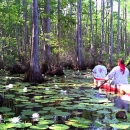Visit Us
Shiawassee National Wildlife Refuge provides several great opportunities to enjoy the outdoors. The mixture of bottomland forests and wetlands creates great waterways for canoeing and kayaking while also being great wildlife observation, hunting and fishing areas.
Location and Contact Information
- Shiawassee National Wildlife Refuge HeadquartersView Details6975 Mower Road Saginaw, MI 48601-9783
- The Wildlife Drive Auto TourView Details6000 Bishop Road Saginaw, MI 48601
About Us
The 10,000 acre Shiawassee National Wildlife Refuge was established in 1953 for use as an inviolate sanctuary and for any other management purposes of migratory birds. The refuge also serves as an ideal destination for recreation. As a designated Important Bird Area, it is a place of global significance for migratory waterfowl.
Our Species
More than 280 species of migratory birds and more than 100 songbirds have been observed on the refuge. The refuge supports numerous species of colonial nesting waterbirds such as ring-billed and herring gulls, great blue herons and great egrets. The refuge is home to several pairs of nesting eagles. In the spring and summer visitors may see eastern fox snakes (non-venomous) or white-trailed deer while on the trails. Muskrats are active throughout the year, swimming along drainage and the wetlands. Visitors might observe American white pelicans resting during the summer in Maankiki Marsh.






















